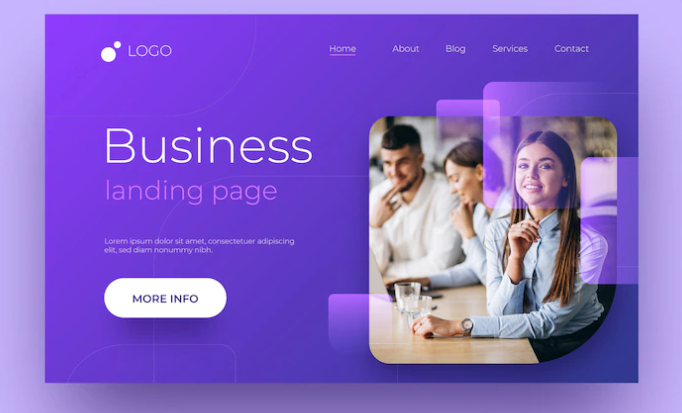Go Global, Stay Local: Strategies for Building a Business Website Across Borders
In our interconnected world, the digital landscape presents boundless opportunities for business websites to expand globally. As you embark on the journey of taking your business website to international markets, it’s essential to remember the importance of staying rooted in the local context. This article delves into the strategies and considerations for building a business website that seamlessly bridges the distance between global reach and local relevance.
Seeking a website developer? We’re here to seamlessly transition your business into the digital world with tailored expertise. Elevate your online presence with us
I. Introduction
In the vast expanse of the internet, the potential to connect with a global audience is unparalleled for your business website. Businesses can transcend borders and reach consumers in different corners of the world. However, amidst this global pursuit, the challenge lies in maintaining a local touch that resonates with diverse audiences.
II. Understanding Global SEO for Your Business Website
A. Definition and Significance
Global Search Engine Optimization (SEO) for your business website is the key to unlocking international markets. It involves optimizing your business website to ensure it ranks well across various regions, languages, and cultures. This isn’t just about language translation; it’s about tailoring your content to diverse audiences worldwide.
B. Key Elements of Global SEO
- Multilingual Keywords: Targeting keywords in multiple languages ensures your content is discoverable globally.
- Utilize keyword research tools to identify relevant terms in different languages.
- Create high-quality, culturally relevant content around these multilingual keywords.
- Hreflang Tags: These tags communicate to search engines about the language and regional targeting of your pages.
- Implement hreflang tags to indicate the language and regional targeting of each page.
- Regularly audit and update hreflang tags as your website expands into new markets.
III. Localized Content Strategies
A. Importance of Regionalized Content
Crafting content that speaks to the cultural nuances of your target audience is critical. This goes beyond language – it’s about understanding and respecting local customs, preferences, and sensitivities.
B. Tailoring Content for Diverse Audiences
- Cultural Sensitivity: Ensure your content respects and aligns with the cultural values of your diverse audience.
- Conduct thorough cultural research to avoid inadvertent cultural missteps.
- Seek feedback from native speakers or cultural experts during content creation.
- Localized Messaging: Tailor your messages to resonate with the specific regions you’re targeting.
- Develop region-specific marketing messages that consider local trends and interests.
- Test different messaging strategies to understand what resonates best with each audience.
IV. Website Localization
A. Translation and Cultural Adaptation
Translation is the first step, but true localization involves adapting your content to align with the cultural expectations of your audience.
B. Technical Aspects of Website Localization
- Geotargeting: Presenting different content based on the user’s location enhances relevance.
- Implement geotargeting to dynamically display content based on the visitor’s location.
- Optimize local landing pages with region-specific information.
- Local Domain Extensions: Using country-specific domain extensions improves local search engine visibility.
- Register country code top-level domains (ccTLDs) for key markets.
- Leverage local domain extensions to build trust and visibility in specific regions.

V. Mobile Optimization for Global Reach
A. The Rise of Mobile Internet Usage Globally
Mobile devices are the primary gateway to the internet for many. Ensuring your website is mobile-friendly is imperative for global accessibility.
B. Strategies for Mobile Optimization on a Global Scale
- Mobile-First Design: Prioritize designing for mobile users first.
- Optimize website design for smaller screens and touch interfaces.
- Test the mobile-friendliness of your site using Google’s Mobile-Friendly Test.
- Responsive Design: Ensure your website adapts seamlessly to different screen sizes.
- Use responsive design principles to create a consistent user experience across devices.
- Monitor and address issues that may arise on specific devices or screen sizes.
VI. Social Media for Global Engagement
A. Importance of Social Media in Global Marketing
Social media is a powerful tool for global engagement. It’s not just about broadcasting your message; it’s about actively participating in conversations and understanding local trends.
B. Crafting a Global Social Media Strategy
- Diverse Platforms: Choose social media platforms popular in your target regions.
- Research the most used social media platforms in each market and tailor your strategy accordingly.
- Adapt your content to suit the preferences and behaviors of users on each platform.
- Localized Content Calendar: Plan your social media content to coincide with the optimal times for different time zones.
- Use scheduling tools to post content at times when your audience is most active.
- Adjust your content calendar based on regional holidays and events.
VII. E-commerce Considerations for Your Business Website
A. Adapting Your Online Store for International Customers
Expanding globally means adapting your online store, i.e., your business website, to meet the expectations of customers from different regions.
B. Addressing Payment and Shipping Concerns on Your Business Website
- Transparent Policies: Clearly communicate shipping costs and delivery times on your business website.
- Provide a transparent breakdown of shipping costs at the checkout stage for your business website.
- Clearly outline estimated delivery times for each region on your business website.
- Localized Customer Support: Provide support in multiple languages and time zones on your business website.
- Offer customer support through various channels, including email, live chat, and phone on your business website.
- Hire multilingual support staff or use translation services for effective communication on your business website.
VIII. Building Trust Across Borders with Your Business Website
A. The Role of Trust in Global Business Websites
Trust is the cornerstone of successful global business websites. Building and maintaining trust require intentional efforts.
B. Strategies for Building Trust with a Diverse Audience on Your Business Website
- Transparent Communication: Clearly communicate your policies and practices on your business website.
- Clearly articulate your business values, return policies, and customer service standards on your business website.
- Address customer concerns promptly and transparently on your business website.
- Localized Guarantees: Offer guarantees that align with regional expectations on your business website.
- Tailor product guarantees to meet the expectations and legal standards of each region on your business website.
- Highlight customer success stories and positive experiences from diverse regions on your business website.
IX. Analytics and Data-driven Decisions
A. Importance of Analytics in a Global Context
Analytics provide insights into how users from different regions interact with your site.
B. Utilizing Data to Refine Global Strategies
- A/B Testing: Experiment with different strategies across regions.
- Conduct A/B tests on various elements, such as call-to-action buttons and product descriptions.
- Analyze the performance of each variant in different markets to inform future strategies.
- Dynamic Content Optimization: Personalize content based on user data.
- Use data to dynamically display content that is relevant to the user’s location and preferences.
- Implement personalization strategies to enhance user engagement and conversion rates.
X. Overcoming Language Barriers
A. Tools for Overcoming Language Challenges
- Translation Plugins: Integrate tools for on-the-fly translation.
- Implement translation plugins that automatically translate content based on the user’s language preferences.
- Ensure translations are accurate and culturally appropriate.
- Multilingual Chat Support: Offer real-time support in multiple languages.
- Provide multilingual chat support to assist users in their preferred language.
- Train support agents to understand and address language-specific queries effectively.
B. Strategies for Effective Communication
- Clear Communication: Use simple and concise language.
- Avoid jargon and complex language to ensure clarity for users from diverse linguistic backgrounds.
- Test the readability of your content using tools like Flesch-Kincaid readability tests.
- Visual Communication: Use visuals to convey messages when language may be a barrier.
- Incorporate visuals, such as infographics and images, to supplement textual content.
- Ensure that visual elements are culturally relevant and convey the intended message.
XI. Challenges and Solutions
A. Common Challenges in Global Website Management
- Technical Challenges: Invest in robust hosting solutions for global accessibility.
- Choose reliable hosting providers with global server locations to minimize downtime.
- Regularly monitor website performance and address technical issues promptly.
- Cultural Missteps: Seek advice from cultural experts during content creation.
- Collaborate with local experts or cultural consultants to review and approve content.
- Conduct cultural sensitivity training for your content creation team.
B. Practical Solutions for Overcoming These Challenges
- Robust Hosting Solutions: Invest in reliable hosting for global accessibility.
- Prioritize hosting providers with a global presence and a track record of high uptime.
- Consider content delivery network (CDN) services to optimize website speed globally.
- Cultural Consultants: Seek advice from cultural experts during content creation.
- Build relationships with cultural consultants who can provide insights into local customs and preferences.
- Establish a feedback loop with consultants to continuously improve cultural alignment.
XII. Case Studies
A. Successful Examples of Websites Going Global
- Amazon: Tailoring its platform for different regions and languages.
- Amazon’s website adapts dynamically to users’ locations, languages, and currency preferences.
- The company invests in localized marketing strategies to resonate with diverse consumer bases.
- Airbnb: Adapting its services to meet diverse cultural expectations.
- Airbnb employs region-specific branding and marketing to connect with local audiences.
- The platform incorporates user-generated content to showcase diverse hosting experiences.
B. Lessons Learned from Their Experiences
- Flexibility: Be adaptable to changing market dynamics.
- Regularly assess market trends and adjust your strategies accordingly.
- Embrace a mindset of continuous improvement based on user feedback and industry developments.
- Continuous Improvement: Iterate based on user feedback and market trends.
- Encourage user feedback through surveys, reviews, and customer support interactions.
- Implement iterative improvements to your website and marketing strategies based on collected feedback.
XIII. Future Trends in Global Web Development
A. Emerging Technologies Shaping the Future
- AI-driven Personalization: Tailoring user experiences based on AI insights.
- Implement artificial intelligence to analyze user behavior and provide personalized recommendations.
- Use machine learning algorithms to predict user preferences and optimize content delivery.
- Blockchain for Trust: Using blockchain to enhance security and transparency.
- Explore blockchain applications to enhance the security of online transactions and user data.
- Leverage blockchain technology to establish transparent supply chains and build trust with consumers.
B. Preparing for the Next Wave of Global Online Trends
- Early Adoption: Stay informed and embrace emerging technologies.
- Regularly monitor industry publications and tech trends to stay ahead of the curve.
- Be prepared to experiment with and adopt new technologies that can enhance your global online presence.
- Agile Development: Be agile to swiftly adapt to changing online landscapes.
- Adopt agile development methodologies to enable quick adjustments to market changes.
- Foster a culture of innovation and agility within your development and marketing teams.
XIV. Conclusion
In the dynamic landscape of global online business, the key is to “Go Global, Stay Local.” By implementing robust global strategies while maintaining a local touch, businesses can successfully navigate the challenges of building a website that bridges distances.



